Couples-focused behavioral interventions for prevention of HIV: systematic review of the state of evidence
- PMID: 18843530
- PMCID: PMC3640442
- DOI: 10.1007/s10461-008-9471-4
Couples-focused behavioral interventions for prevention of HIV: systematic review of the state of evidence
Abstract
HIV is frequently transmitted in the context of partners in a committed relationship, thus couples-focused HIV prevention interventions are a potentially promising modality for reducing infection. We conducted a systematic review of studies testing whether couples-focused behavioral prevention interventions reduce HIV transmission and risk behavior. We included studies using randomized controlled trial designs, quasi-randomized controlled trials, and nonrandomized controlled studies. We searched five electronic databases and screened 7,628 records. Six studies enrolling 1,084 index couples met inclusion criteria and were included in this review. Results across studies consistently indicated that couples-focused programs reduced unprotected sexual intercourse and increased condom use compared with control groups. However, studies were heterogeneous in population, type of intervention, comparison groups, and outcomes measures, and so meta-analysis to calculate pooled effects was inappropriate. Although couples-focused approaches to HIV prevention appear initially promising, additional research is necessary to build a stronger theoretical and methodological basis for couples-focused HIV prevention, and future interventions must pay closer attention to same-sex couples, adolescents, and young people in relationships.
Figures
References
-
- Adimora AA, Schoenbach VJ, Martinson FE, Donaldson KH, Stancil TR, Fulliove RE. Concurrent partnerships among rural African Americans with recently reported heterosexually transmitted HIV infection. Journal of Acquired Immune Deficiency Syndrome. 2003;34:423–429. - PubMed
-
- Ajzen I, Albarracin D, Hornik R. Prediction and change of helath behavior: Applying the Reasoned Action Approach. Lawrence Erlbaum Associates; Mahwah, NJ: 2007.
-
- Albarracin D, Gillette JC, Moon-Ho H, Early AN, Glasman LR, Durantini MR. A test of major assumptions about behaviour change: A comprehensive look at the effects of passive and active HIV-prevention interventions since the beginning of the epidemic. Psychological Bulletin. 2005;131:865–897. - PMC - PubMed
-
- Allen S, Meinzen-Derr J, Kautzman M, Zulu I, Trask S, Fideli U, Musonda R, Kasolo F, Gao F, Haworth A. Sexual behavior of HIV discordant couples after HIV counseling and testing. AIDS. 2003;17:733–40. - PubMed
Publication types
MeSH terms
Grants and funding
LinkOut - more resources
Full Text Sources
Medical
Miscellaneous


